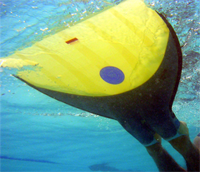What is Monofin Swimming?

Monofin swimming is swimming with an aid of a single-bladed swim fin. This was introduced in the 1972 Finswimming Championships in Moscow. The monofin resembles a dolphin tail which is capable of propelling swimmers up to 12 kph.
Monofin Movement
 The primary movement in monofin swimming is the undulation forwards of the hip and
the descendant impulse of the legs. The main source of power derives
from the swimmer's midsection,
involving the lower abdominal and back muscles, buttocks and quadriceps.
The primary movement in monofin swimming is the undulation forwards of the hip and
the descendant impulse of the legs. The main source of power derives
from the swimmer's midsection,
involving the lower abdominal and back muscles, buttocks and quadriceps.
 The monofin swimmer extends the arms forward, locking hands together,
blocking the head between the biceps. The undulating movement starts in the shoulders,
with maximum amplitude towards the hips;
the legs almost don't bend to transfer the movement of the monofin.
This technique is called dolphin kick.
The monofin swimmer extends the arms forward, locking hands together,
blocking the head between the biceps. The undulating movement starts in the shoulders,
with maximum amplitude towards the hips;
the legs almost don't bend to transfer the movement of the monofin.
This technique is called dolphin kick.
4 Monofin Swimming Events
- Surface
- Apnea/Breatholding
- Immersion (Scuba)
- Long Distance
[ Back to top ]
Monofin Technique (from "Monofins: A Serious Training Tool" by Paolo Morales)
- Streamline. Extend arms as far as possible and overlap hands,
which are clasped together by the thumb of the top hand. Tuck head
securely beneath the biceps while reducing triangle-shaped space between the arms.
Compress body to remove as much resistance as possible.
- Hunch the Neck and Shoulders Slightly. While streamlined,
slightly hunch the neck and shoulders without dropping hands off the head.
This does not only initiate the crucial undulation that will also grow as it reaches
the hips, but also helps the upper body in a more aligned position while creating
a forward "over-the-top-of-a-small-wave" sensation.
- Drive the Legs. With heels up and knees slightly bent,
quadriceps flex and feet are driven downward in unison and with equal force.
- Hips Forced Up. As the feet drive down, the body's
undulation reaches the hips, which are forced up to
accentuate the power of the downward kick. Do not drop
the hands, but keep them oriented forward and in alignment with
the upper body from the waist up.
- Hips Slide Forward. Thrust the hips forward to assist the
sweep of the upbeat kick and to get the heels ready more
quickly for the propulsive downbeat. This hip thrust should
also trigger the neck and shoulder hunch, starting the body's
undulation and monofinning cycle all over again. The feeling
created should be of the hips sliding forward as the speed
created from the downbeat is maintained. Transition from the
up position of the hips to the hip thrust forward should be
smooth and continuous with no delay between the respective motions.
[ Back to top ]